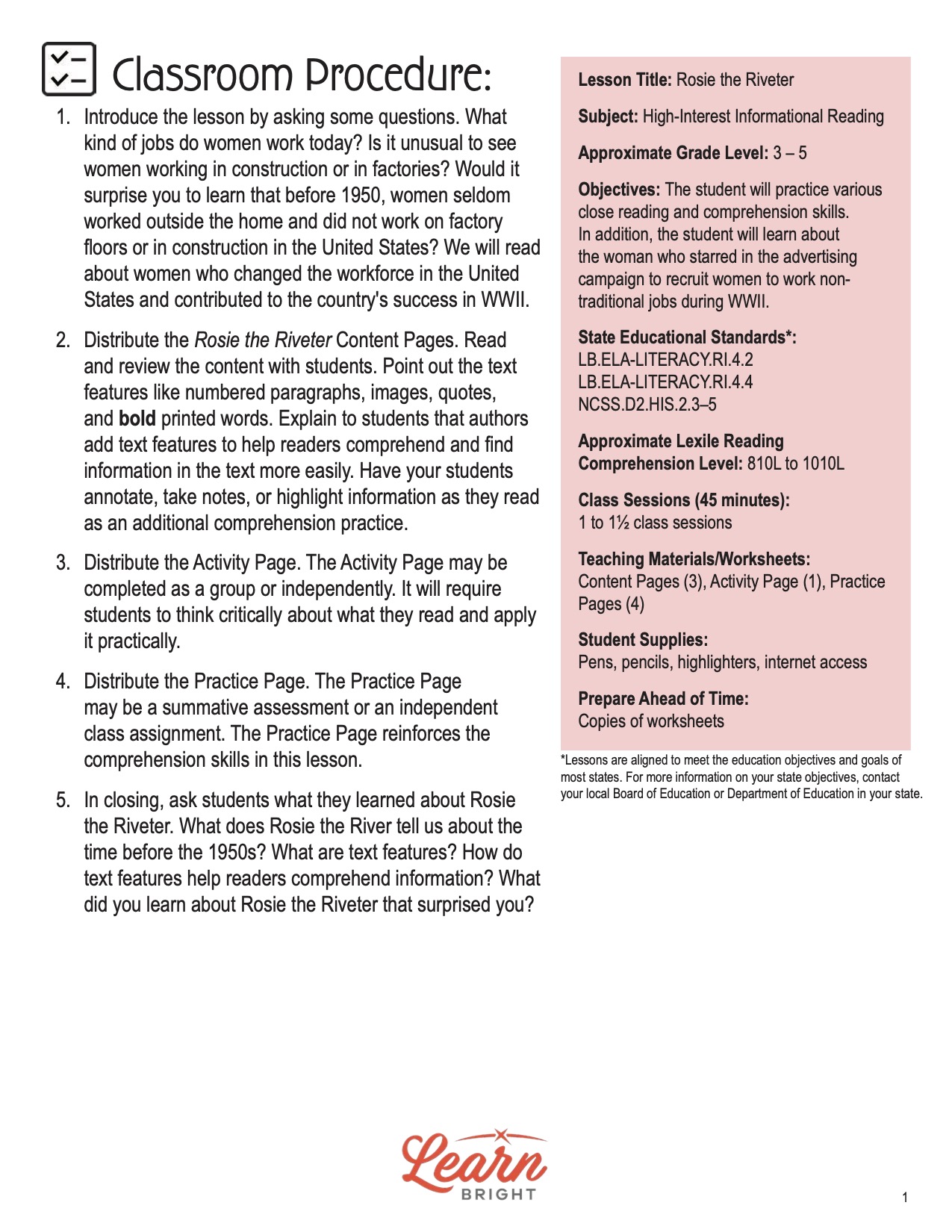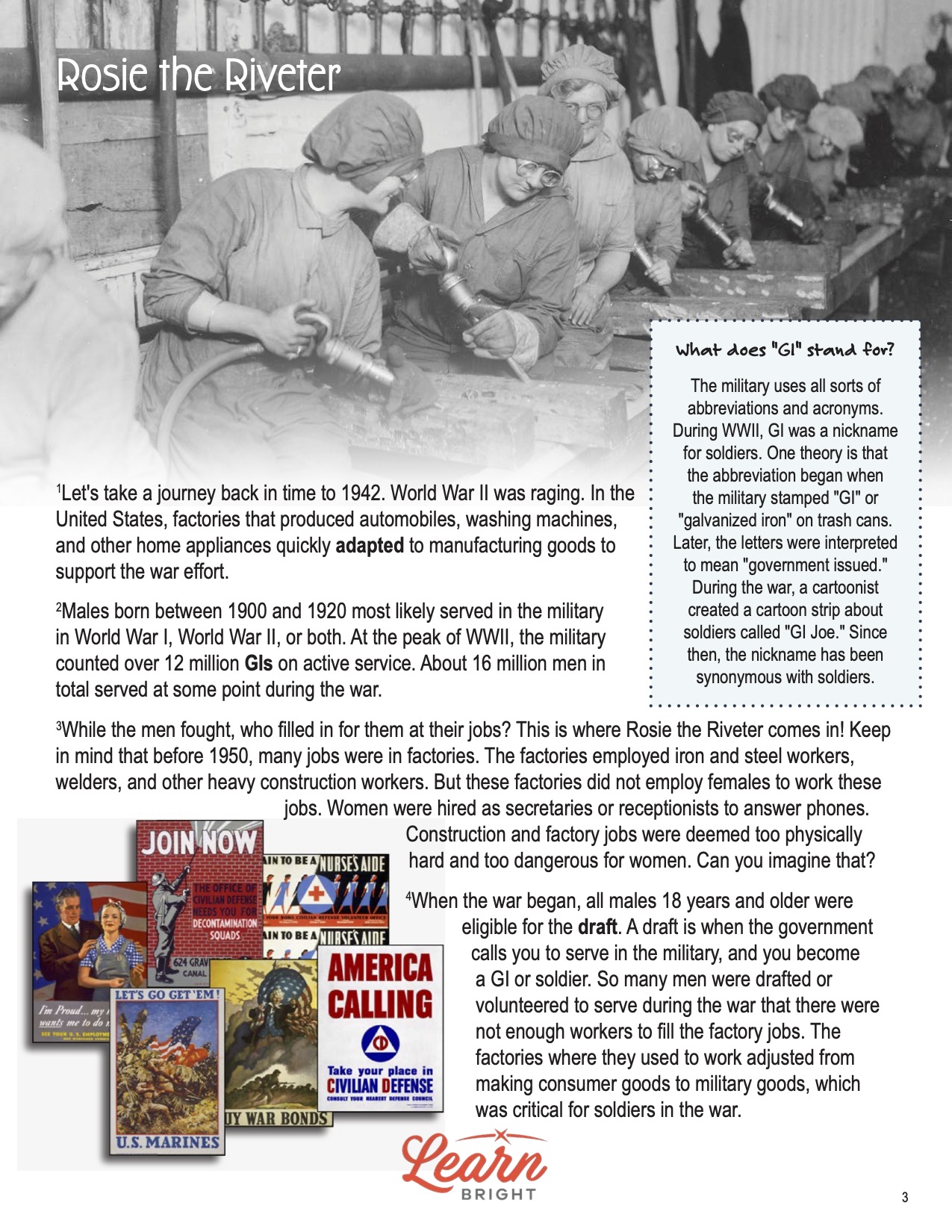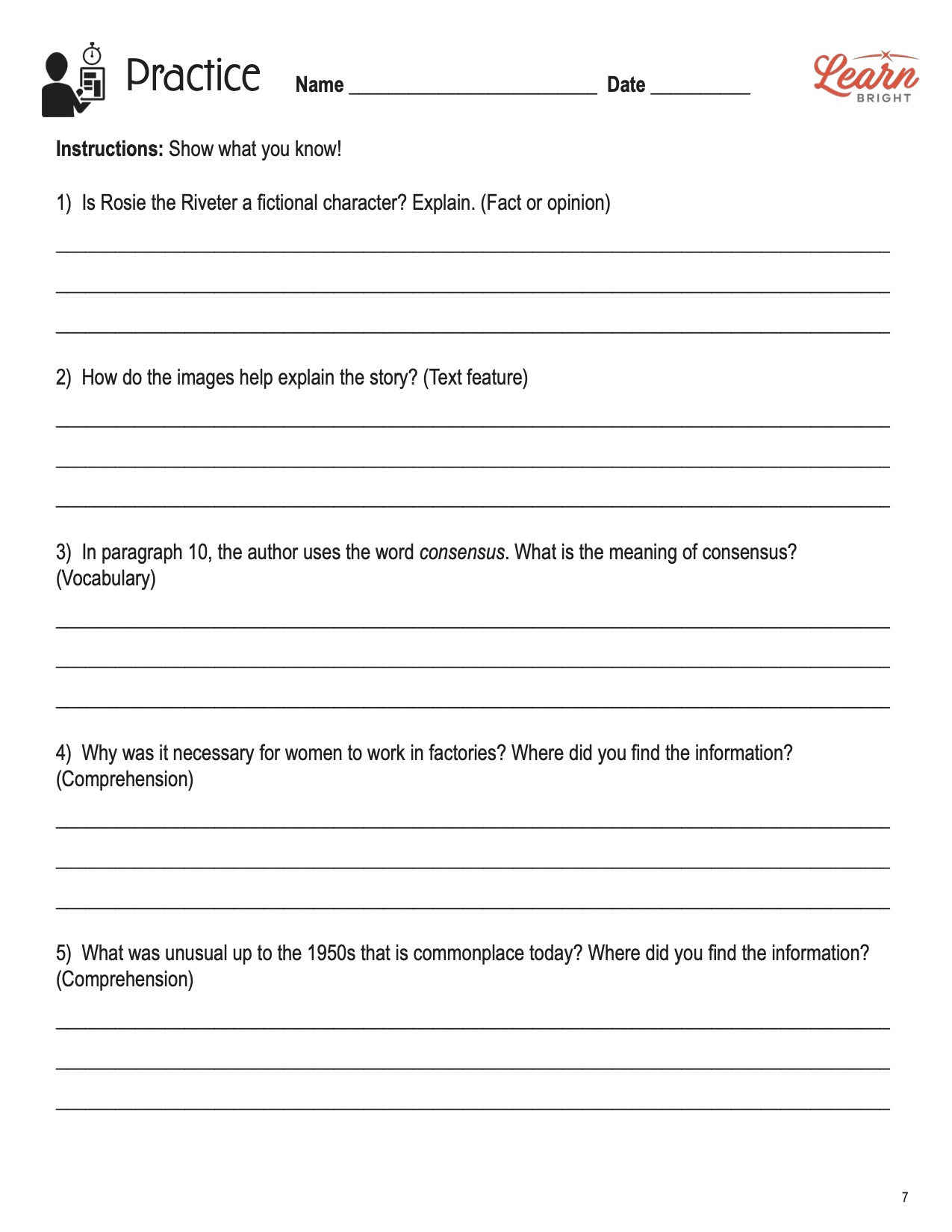Description
What our Rosie the Riveter lesson plan includes
Lesson Objectives and Overview: Rosie the Riveter is a high-interest reading comprehension lesson plan. As such, students will practice various close reading and comprehension skills. In addition, they will learn about the women who took over factory jobs during WWII. This lesson is for students in 3rd grade, 4th grade, and 5th grade.
Classroom Procedure
Every lesson plan provides you with a classroom procedure page that outlines a step-by-step guide to follow. You do not have to follow the guide exactly. The guide helps you organize the lesson and details when to hand out worksheets. It also lists information in the yellow box that you might find useful. You will find the lesson objectives, state standards, and number of class sessions the lesson should take to complete in this area. In addition, it describes the supplies you will need as well as what and how you need to prepare beforehand.
Teacher Notes
The paragraph on this page gives you a little more information on the lesson overall and describes what you may want to focus your teaching on. It explains that you can teach this lesson in a whole-class setting or as an independent, small-group activity. The blank lines are available for you to write out any thoughts or ideas you have as you prepare.
ROSIE THE RIVETER LESSON PLAN CONTENT PAGES
Raging WWII
The Rosie the Riveter lesson plan includes three content pages. Let’s take a journey back in time to 1942. World War II was raging. In the United States, factories that produced automobiles, washing machines, and other home appliances quickly adapted to manufacturing goods to support the war effort.
Males born between 1900 and 1920 most likely served in the military in World War I, World War II, or both. At the peak of WWII, the military counted over 12 million GIs on active service. About 16 million men in total served at some point during the war.
While the men fought, who filled in for them at their jobs? This is where Rosie the Riveter comes in! Keep in mind that before 1950, many jobs were in factories. The factories employed iron and steel workers, welders, and other heavy construction workers. But these factories did not employ females to work these jobs. Women were hired as secretaries or receptionists to answer phones. Construction and factory jobs were deemed too physically hard and too dangerous for women. Can you imagine that?
Drafting and GI Joes
When the war began, all males 18 years and older were eligible for the draft. A draft is when the government calls you to serve in the military, and you become a GI or soldier. So many men were drafted or volunteered to serve during the war that there were not enough workers to fill the factory jobs. The factories where they used to work adjusted from making consumer goods to military goods, which was critical for soldiers in the war.
To fill the jobs critical to the war effort, factories decided on a radical idea—they would recruit and train women! Women would produce the tanks, planes, ships, munitions, and everything else the soldiers needed. Problem solved? Not quite. First, they had to convince women that working in a hot, dirty, dusty, and dangerous factory was better than working in an office. At the time, only about 1% of women in the workforce worked on factory floors.
The lesson also describes where the “GI” in GI Joe comes from. The military uses all sorts of abbreviations and acronyms. During WWII, GI was a nickname for soldiers. One theory is that the abbreviation began when the military stamped “GI” or “galvanized iron” on trash cans. Later, the letters were interpreted to mean “government issued.” During the war, a cartoonist created a cartoon strip about soldiers called “GI Joe.” Since then, the nickname has been synonymous with soldiers.
Advertising Rosie
The US government and manufacturers decided on a clever advertising campaign. It focused on recruiting women for non-traditional jobs like welding or riveting. The star of the advertising campaign was Rosie the Riveter. What is a riveter? A riveter is someone whose job is to fasten things using metal pins called rivets. Rivets hold the parts of an iron ship’s hull together. They also hold a plane’s wings together. Rivets are essential to fastening things that are made of metal.
The Rosie character was in movies, newspapers, photographs, and articles. Television was invented in 1927 but did not become widely used until the 1950s. So people in the 1940s got most of their news from newspapers or the radio. An artist named J. Howard Miller designed a Rosie the Riveter poster for Westinghouse Electric Corporation under the headline “We Can Do It!”
Magazines were popular, and the Saturday Evening Post was one of the first to publish a cover image of Rosie. Drawn by the famous artist Norman Rockwell, Rosie was featured with an American flag. The American flag emphasized women’s patriotic duty to join the war effort and work in factories. Soon after, different versions of Rosie appeared in newspapers, movie newsreels, and magazines. Posters of the character were also nailed to walls anywhere people might visit. There was even a song about Rosie that played on the radio in 1943!
Who Was Rosie the Riveter?
So Rosie was a fictional character, right? Not exactly! While she was created to recruit women to work in factories during WWII, her image was based on actual women. Rosie probably had several different models. No one knows for sure who was the first. Some historians credit Miller as the artist who created the Rosie character. His model was Geraldine Hoff Doyle. She worked in a Navy machine shop during WWII.
Another model may have been Rose Will Monroe. She worked as a riveter at the Willow Run Bomber Plant. Other historians think Rosalind P. Walter, the Rosie from the famous song, could be the original Rosie. Rosalind was a riveter on Corsair fighter planes. While there is no consensus opinion, many historians believe the original model for Rosie was Naomi Parker Fraley. Naomi was photographed working in the Alameda California Naval Air Station machine shop. The photograph was taken in 1942. Naomi is wearing the trademark polka-dotted bandana.
Black Rosies and Post-War Honors
Though they were not portrayed, it should not be forgotten that many African American women also worked tirelessly in factories during the war. These women became known as the “Black Rosies.” They worked as sheet metal workers, explosive assemblers, shipbuilders, and mechanics. One Black Rosie, Ruth Wilson, became a sheet metal worker during World War II. She was in her early twenties at the time. In an interview, Ruth recalled her experience. After taking a test at the Naval Yard, Ruth went to a vocational school. “I ended up going to sheet metal school,” Wilson said. She would install bulkheads on the USS Valley Forge, a WWII aircraft carrier.
On April 10, 2024, eight decades after the war, 27 Rosies traveled to Washington, DC, to receive the nation’s highest civilian honor—the Congressional Medal of Honor. Most were in their late nineties, and the oldest was 106 years in age. They traveled from all parts of the US to attend the event. The Rosies represent the American value of doing what is necessary when duty calls. These women inspire anyone who believes courage and conviction are best served through action.
ROSIE THE RIVETER LESSON PLAN WORKSHEETS
The Rosie the Riveter lesson plan includes two worksheets: an activity worksheet and a practice worksheet. Each one will help students solidify their grasp of the material they learned throughout the lesson. You can refer to the classroom procedure guidelines to know when to hand out each worksheet.
INSPIRATIONAL POSTER ACTIVITY WORKSHEET
For the activity, students will design and create an inspirational poster. After looking at other patriotic posters and art online, they will create a poster of their own. The poster should encourage someone to try something they may not think they could do.
If you like, you could have students use the worksheet as a rough draft. Once they complete the draft, they could transfer a final copy onto poster board or construction paper. You could display their artwork in the classroom.
ROSIE THE RIVETER PRACTICE WORKSHEET
The practice worksheet lists 10 questions based on the content. These questions all relate to the content pages, so students will need to refer to them often for the answers. In addition, each question provides which reading tool the question corresponds to, such as text feature, vocabulary, or comprehension.
Worksheet Answer Keys
At the end of the lesson plan document is an answer key for the practice worksheet. The correct answers are all in red to make it easier for you to compare them with students’ responses. If you choose to administer the lesson pages to your students via PDF, you will need to save a new file that omits these pages. Otherwise, you can simply print out the applicable pages and keep these as reference for yourself when grading assignments.









